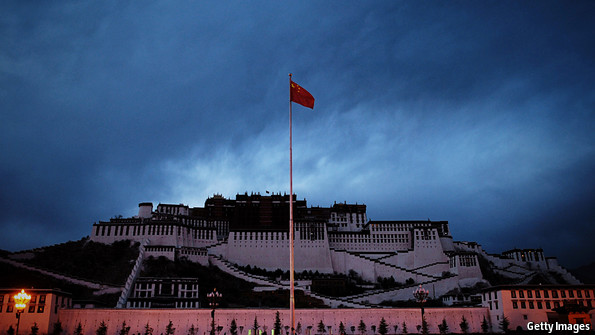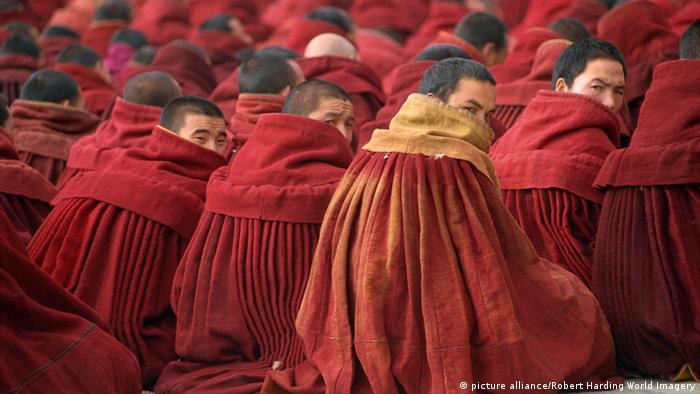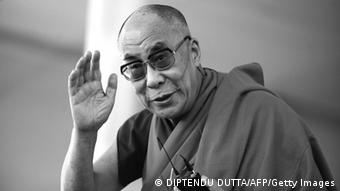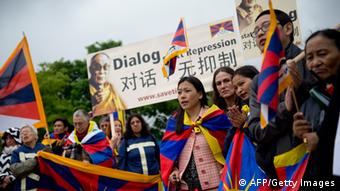中共当局再显对藏强硬手腕
| 中共高层抨击“中间道路”与宪法对立;海外团体称, |
据德新社报道,中国政府显然又允许藏人张贴、悬挂达赖喇嘛画像。
有消息称中国当局最近对达赖喇嘛的法相解禁,引发各方猜测政府意在调整西藏政策,缓解藏区紧张局势。但同时,也有媒体报道称中国政府并没有改变当前的政策,达赖喇嘛法相依然被禁。
(德国之声中文网)总部设在伦敦的自由西藏组织援引知情人士向路透社表示,中国官方解除了一项禁止西藏僧人悬挂达赖喇嘛法相的禁令。路透社分析称,这一令人意外的政策转变可能会缓解西藏的紧张局势。
这一决定涉及拉萨知名寺院甘丹寺,这也是西藏历史中最重要的宗教寺院之一。中国当局从1996年开始,禁止在该寺庙中悬挂达赖喇嘛的法相。
习近平带来西藏新政?
路透社报道称,这项禁令解除的同时,西藏其它地区政府也考虑作出类似的政策调整。这可能预示着当局准备通过政策上的变化放松对西藏的宗教管制,而此时正逢习近平上任三个月后。
位于美国的国际声援西藏运动组织也透露,中国西部省份青海的官员也考虑取消悬挂这位西藏流亡精神领袖法相的禁令。该组织声称青海地区起草的建议考虑应该停止强迫藏人谴责达赖喇嘛的做法,并减少部署在寺院内的警力。到目前为止,路透社无法找到拉萨和青海的官方对此置评。
该报道分析称,在一系列抗议中国统治的藏人自焚事件发生后,政府为了缓和与藏人之间的紧张关系,经过精心安排后推出了相关政策。
中国官方反驳?
但同时也有报道声称中国当局并没有更改现有的政策。英国广播电台BBC本周五(6月28日)援引中国国家宗教事务局报道称,中国并没有“解禁”达赖喇嘛法相。
甘丹寺新政策的传闻以及青海地区的讨论出现的时机正值中央党校的一位学者发表了质疑中国西藏政策的观点后。中央党校民族宗教理论室主任靳薇接受香港《亚洲 周刊》采访时,提出了一些解决西藏问题的新概念。比如应该"商议让达赖喇嘛纯粹以宗教领袖的身份访问香港或澳门,将来可以考虑让达赖喇嘛居留香港。"
而到目前为止,中国国家主席习近平对于西藏的公开表态不多。路透社报道称,习近平父亲习仲勋生前曾是一位开明的副总理,和达赖喇嘛的关系甚密。这位藏人领袖曾经于50年代向习仲勋赠送过一块名贵手表,而习仲勋几十年后还一直戴着它。
国际声援西藏运动组织发言人桑德斯(Kate Saunders)告诉路透社:"现在有越来越多的人认为,由于西藏局势性质关键,值得讨论改变目前强硬的西藏政策,让达赖喇嘛以某种方式参与其中。"
"他们说我们应该感激"
另一方面,中国政府颇具争议的牧民定居政策已经从根本上改变了许多藏人的生活方式。纽约"人权观察"组织最近公布的一份名为"他们说我 们应该感激"(They Say We Should Be Grateful)的报告中指出,有超过两百万生活在中国的藏民被迫迁居,搬到政府出资修建的住所中,破坏了藏民的文化和原有的生活方式。报告表示,受此 影响的人数"超过西藏自治区总人口的三分之二。"
"人权观察"组织发言人理查森(Sophie Richardson)表示:"后毛泽东时代中,西藏农村居民迫于大范围搬迁政策的压力,住所被改建的速度和规模都是前所未有的……藏人在制定政策方面没 有发言权,正在从根本上改变自身的生活方式。在高压政策的背景下,他们无法向现有的西藏政策发起挑战。"
针对"人权观察"最新公布的报告,中国政府予以强烈反驳。外交部发言人华春莹于本周四(6月27日)向出席例会的记者表示:"所提及的组织经常故意批评中 国,发表无端的声明……我不会去仔细看他们的报道,也不愿就此置评……西藏最近几十年来在各个领域,包括政治、经济和社会方面的发展取得了巨大的进步。这 是不可否认的事实。"
综合报道:任琛
责编:石涛
这一决定涉及拉萨知名寺院甘丹寺,这也是西藏历史中最重要的宗教寺院之一。中国当局从1996年开始,禁止在该寺庙中悬挂达赖喇嘛的法相。
习近平带来西藏新政?
路透社报道称,这项禁令解除的同时,西藏其它地区政府也考虑作出类似的政策调整。这可能预示着当局准备通过政策上的变化放松对西藏的宗教管制,而此时正逢习近平上任三个月后。
位于美国的国际声援西藏运动组织也透露,中国西部省份青海的官员也考虑取消悬挂这位西藏流亡精神领袖法相的禁令。该组织声称青海地区起草的建议考虑应该停止强迫藏人谴责达赖喇嘛的做法,并减少部署在寺院内的警力。到目前为止,路透社无法找到拉萨和青海的官方对此置评。
该报道分析称,在一系列抗议中国统治的藏人自焚事件发生后,政府为了缓和与藏人之间的紧张关系,经过精心安排后推出了相关政策。
中国官方反驳?
但同时也有报道声称中国当局并没有更改现有的政策。英国广播电台BBC本周五(6月28日)援引中国国家宗教事务局报道称,中国并没有“解禁”达赖喇嘛法相。
甘丹寺新政策的传闻以及青海地区的讨论出现的时机正值中央党校的一位学者发表了质疑中国西藏政策的观点后。中央党校民族宗教理论室主任靳薇接受香港《亚洲 周刊》采访时,提出了一些解决西藏问题的新概念。比如应该"商议让达赖喇嘛纯粹以宗教领袖的身份访问香港或澳门,将来可以考虑让达赖喇嘛居留香港。"
而到目前为止,中国国家主席习近平对于西藏的公开表态不多。路透社报道称,习近平父亲习仲勋生前曾是一位开明的副总理,和达赖喇嘛的关系甚密。这位藏人领袖曾经于50年代向习仲勋赠送过一块名贵手表,而习仲勋几十年后还一直戴着它。
国际声援西藏运动组织发言人桑德斯(Kate Saunders)告诉路透社:"现在有越来越多的人认为,由于西藏局势性质关键,值得讨论改变目前强硬的西藏政策,让达赖喇嘛以某种方式参与其中。"
"他们说我们应该感激"
另一方面,中国政府颇具争议的牧民定居政策已经从根本上改变了许多藏人的生活方式。纽约"人权观察"组织最近公布的一份名为"他们说我 们应该感激"(They Say We Should Be Grateful)的报告中指出,有超过两百万生活在中国的藏民被迫迁居,搬到政府出资修建的住所中,破坏了藏民的文化和原有的生活方式。报告表示,受此 影响的人数"超过西藏自治区总人口的三分之二。"
"人权观察"组织发言人理查森(Sophie Richardson)表示:"后毛泽东时代中,西藏农村居民迫于大范围搬迁政策的压力,住所被改建的速度和规模都是前所未有的……藏人在制定政策方面没 有发言权,正在从根本上改变自身的生活方式。在高压政策的背景下,他们无法向现有的西藏政策发起挑战。"
针对"人权观察"最新公布的报告,中国政府予以强烈反驳。外交部发言人华春莹于本周四(6月27日)向出席例会的记者表示:"所提及的组织经常故意批评中 国,发表无端的声明……我不会去仔细看他们的报道,也不愿就此置评……西藏最近几十年来在各个领域,包括政治、经济和社会方面的发展取得了巨大的进步。这 是不可否认的事实。"
综合报道:任琛
责编:石涛
Tibet policy
Bold new proposals
Welcome signs that some officials are at last starting to question policies on Tibet

So for a Chinese scholar, Jin Wei, who is director of ethnic and religious studies at the Central Party School in Beijing, to call for a “creative” new approach is startling. For her to do so publicly, in an interview this month with a Hong Kong magazine, Asia Weekly, suggests that she has high-level backing. A report from a Beijing think-tank in 2009 challenged the official line that rioting in Tibet the year before was instigated from abroad. But Robert Barnett, a professor of Tibetan studies at Columbia University in New York, describes Ms Jin’s intervention as a sign that, after two decades, “debate has re-emerged within China about the government’s hard-line policies in Tibet”. Ms Jin even accused former party chiefs in Tibet of being “biased against the practice of religious affairs”. This, she said, “foreshadowed the accumulation of grievances today.”
One former party secretary in Tibet (from 1988-92) was Hu Jintao, who went on to head the party nationally for ten years until last November, when he gave way to Xi Jinping. Those who have forecast that Mr Xi might prove a bolder reformer than the cautious Mr Hu have so far seen little to back them up. Here, on Tibet, is at least a hint of a crack in the hardline consensus. Some have detected another in the appointment of Yu Zhengsheng to head the party’s main policy group on Tibet and Xinjiang, a Muslim-majority region in the north-west. Mr Yu is the head of an advisory body designed to promote national unity. Previous heads of the group have been security specialists.
This is new
Ms Jin’s analysis, though couched in the terminology of party
orthodoxy, is similar to that of many foreign observers. She argues
that, by demonising the Dalai Lama, and viewing any expression of
Tibetan culture as potentially subversive, the party has turned even
those Tibetans sympathetic to its aims against it. The struggle has
evolved from “a contradiction between the central government and the
Dalai Lama separatist clique into an ethnic conflict between Han Chinese
and Tibetans”.She is not advocating a new soft approach to “political” issues, such as the Dalai Lama’s call for greater autonomy for Tibet and Tibetans’ hankering after a “greater Tibet”—ie, within its historic borders, beyond the TAR. But in fact, most protests in Tibet are not about “politics”, defined like this. Many have been sparked by anger at Chinese repression—of Tibetan culture, language and tradition, or of individual protesters. It is a vicious circle, made worse by anger at the large-scale immigration into Tibet of Han Chinese.
Ms Jin has ideas on how to break the impasse. Talks with the Dalai Lama’s representatives, stalled since the most recent of nine fruitless rounds in 2010, should resume, she says. They should concentrate on “easy” issues first, setting contentious debate about Tibet’s status to one side for now. China should consider inviting the Dalai Lama to visit one of its semi-autonomous cities, Hong Kong or Macau, and eventually allowing him back to Tibet. It should also try to defuse the crisis his death will bring by agreeing with him on a chosen reincarnation from inside China’s borders. Otherwise, China risks having to deal with two incarnations: one it endorses and one in exile who is more likely to be revered by most Tibetans.
One of the many obstacles to Ms Jin’s unlikely vision is the identity of China’s negotiating partner. China will only talk to the Dalai Lama’s representative. But two years ago the Dalai Lama retired from his “political” role, ceding it to an elected “prime minister” of the exiles’ government, Lobsang Sangay. Mr Sangay has not done a good job of uniting the exiles and winning their trust. In any event China will not even contemplate talking to him. The Dalai Lama may need, in one respect at least, to come out of retirement.
The debate Ms Jin’s comments have provoked will not bring any immediate relief to Tibetans in Tibet. The infrastructure of Chinese repression is being enhanced and refined, with the implementation of a new “grid” system of street-level surveillance (see article). Dissenters are still locked up every week.
Moreover Ms Jin’s is still a lone voice, at least in public. Few others seem to realise that a new approach in Tibet is in China’s interest. Not only would it ease tension in Tibet; it would help relations with other minorities in China, make reunification with Taiwan more likely and improve China’s relations with the outside world. The more conventional Chinese view is the one voiced recently by a scholar at a Beijing think-tank: “The old Dalai will die soon. End of problem.” Though the Dalai Lama seems in good health, he turns 78 next month. The hope is that Ms Jin will not be the only Chinese adviser to understand that the dying in exile of this Dalai Lama would not be the end of China’s difficulties in Tibet. Rather, his death risks an explosion of violence and the rekindling of a Tibetan independence movement that is for now kept in check by the Dalai Lama’s search for a “middle way”.



沒有留言:
張貼留言